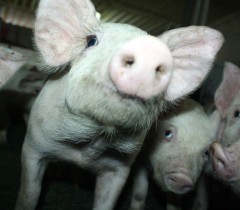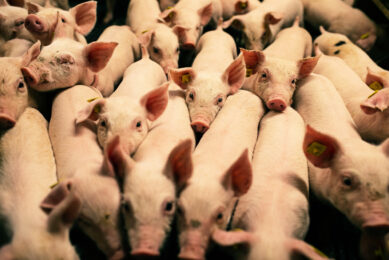Milk and special diets fail to reduce S. suis in weaners

Adding either milk or special feed to weanling piglet diets does not reduce the number of weaned piglets with clinical signs of an infection with Streptococcus suis.
This was the outcome of two recent experiments at the Dutch Swine Innovation Centre Sterksel, part of Wageningen University. The research was supervised by Dr Carola van der Peet-Schwering.
Main question in the trials was whether the supply of milk after weaning can increase the energy intake of the weaned piglets and reduce the number of weaned piglets with clinical signs of an infection with Streptococcus suis (S. suis).
Pre-starter diet
Moreover, it was investigated whether the supply of a specially prepared pre-starter diet can increase the energy intake of the weaned piglets and reduce the number of weaned piglets with clinical signs of an infection with S. suis. This diet consisted of with a lower level of non-digestible crude protein and with higher levels of gelatinised corn, acids, coconut oil and fermentable non-starch polysaccharides.
In the trials described in this report, milk was supplied during the first three days after weaning. In total 320 weaned piglets (ten piglets per pen) were allotted to a 2 x 2 factorial experiment. Treatments were:
• Milk versus no milk: piglets received no milk after weaning or they received the first three days after weaning a milk product which was specially developed for this trial. All piglets received a pre-starter diet.
• Control pre-starter diet (diet A) versus an optimised pre-starter diet (diet B): piglets received the pre-starter diets the first 14 days after weaning. Then all piglets were switched to the same starter diet.
Weaned piglets were followed from weaning till 35 days after weaning. The number of culled and veterinary treated piglets and the number of piglets with clinical signs of an infection with S. suis was registered daily.
Results and conclusions
Energy intake after weaning can be increased by the supply of milk after weaning. Energy intake and daily gain in the first week after weaning were respectively 0.14 EW/d and 86 g/d higher in piglets that were fed milk during the first three days after weaning than in piglets that received no milk after weaning.
From day 7 to 14 after weaning, energy intake (0.51 versus 0.45 EW/d) and daily gain (382 versus 341 g/d) were higher in milk fed piglets than in piglets that received no milk. Feed conversion ratio was similar in both groups.
From weaning to day 35, energy intake (0.72 versus 0.66 EW/d) and daily gain (458 versus 424 g/d) were higher in milk fed piglets than in piglets that received no milk.
The supply of milk after weaning did not reduce the number of weaned piglets with clinical signs of an infection with S. suis (19 of 160 piglets in both groups). Yield per delivered piglet was € 1.04 lower in milk fed piglets than in piglets that received no milk.
Weaned piglets that received pre-starter diet B had a higher energy intake from weaning to day 14 and from weaning to day 35 than weaned piglets that received pre-starter diet A. Daily gain and feed conversion ratio were similar in piglets that were fed pre-starter diet A or B.
Pre-starter diet B did not reduce the number of weaned piglets with clinical signs of an infection with S. suis (21 versus 17 piglets) and the number of culled piglets (3 versus 2) compared to prestarter diet A.
Yield per delivered piglet was similar in piglets that received pre-starter diet A or B.
Milk increased energy intake
Based on the results of the two experiments, it can be concluded that the supply of milk after weaning increased the energy intake and daily gain of the piglets in the first week after weaning and from weaning to day 35. However, the supply of milk did not reduce the number of piglets with clinical signs of an infection with S. suis. It seems that a higher energy intake after weaning will not reduce the number of piglets with clinical signs of an infection with S. suis.
Pre-starter diet B did not improve the performance of the piglets in both experiments. Pre-starter B can reduce the number of piglets with clinical signs of an infection with S. suis (experiment 1) but this is not always the case (experiment 2). It is not clear why pre-starter B reduced the number of piglets with clinical signs of an infection with S. suis in the first experiment but not in the second experiment.
The research was done by order of the Dutch Product Board for Livestock and Meat, the Dutch Product Board for Animal Feed and the Dutch Ministry of Economic Affairs, Agriculture and Innovation.
Earlier research focused on the supply of milk during the first six days after weaning. The results of this experiment were published last year.
Related websites:
• Dutch Swine Innovation Centre Sterksel
• Wageningen University (WUR)
• Dutch Ministry of Economic Affairs, Agriculture and Innovation











